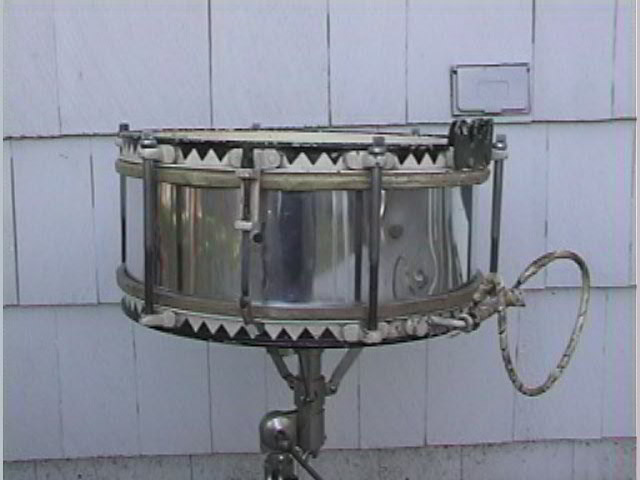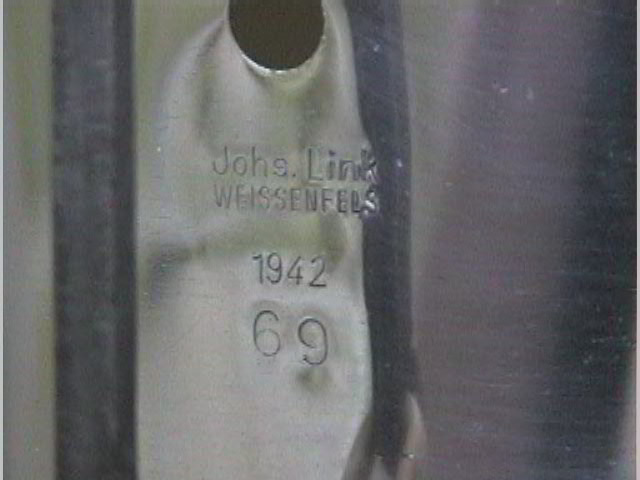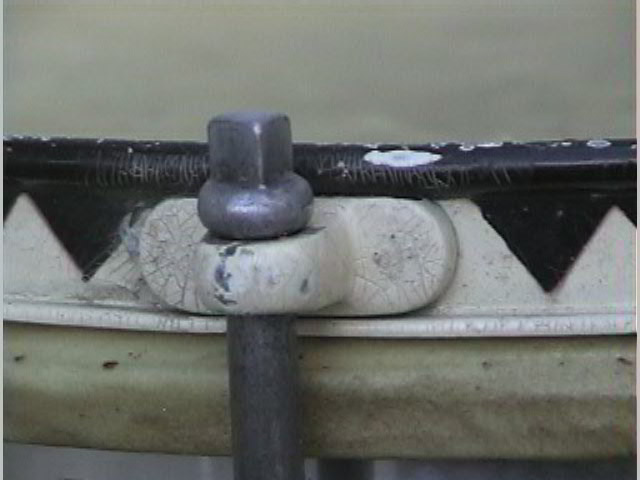WWII Sonor Drum!!!
a 1942 Johannes Link parade snare

Thanks to John Shaw for sharing the photos of this interesting piece of Sonor History. (He outbid me on ebay for this one!!)
Here is John's description of the drum:
The drum is all metal, including the rims. The shell may be made of stainless steel, but I will have to check on this. I say this because the tension rods have some rust, but the neither the shell nor the exposed portions of the rims have rust.
(Later inspection found the shell to be aluminum)
The drum has six single-tension rods. The rods are rather thick, and have triangular heads. The tension rods pass through cast eyelets that are riveted or bolted onto the rims.
The drum has a thumbscrew snare release. The snares pass through a simple hook on the snare release side and wrap around a knob at the butt end.
The drum has 4 gut snares.
There are no markings on the drum other than the following below the vent hole:
Johns Link
Wedissenfels
1942
69

The batter head is split, but the snare head is intact; the latter is not slunk calf, but normal calf scraped thin. The batter head is thick gauge calf.
The drum is quite heavy (naturally, with metal rims, thick tension bolts)
Here is something that intrigues me.....and may be a puzzle you and I can solve together. The drum clearly has some very primitive features (single-tension rods, thumbscrew snare release) combined with more advanced features (cast eyelets riveted onto the rims). Hence the question: why this design? The American drum manufactures made single-tension marching drums, but every single-tension drum I've seen also used cheap clip hooks on the rims. Why didn't Sonor? If Sonor went to the effort of cast eyelets, why didn't they also use lugs?
One possibility: the design may have been one long used by the German Military? Your web site depicted the frontpiece from an early Sonor catalog illustrating a 'Prussian' drummer playing a drum that looks quite like this one. It would be nice to know the origin of the design on this drum. Do you have any artwork from early Sonor drums that might clear this up?
(My opinion is that Otto Link was making use of existing dies and parts stockpiles. It wasn't until 1943 or so that Hitler mandated the cessation of consumer goods manufacture, hence the drum being made of a war materiel. I think Link had a cache of tension rods & simple strainers from the 20's & 30's and only needed to fabricate the rim and shell. This was more than likely a government contract job after all -- and notice, even on government work how they porcelain enameled the rim below... Would Wm. Ludwig, Sr. or Bud Slingerland have made one this way? NOT!
Great pics, John! I've noticed several of these snare drums in old Nazi footage on the History Channel since you sent these pics...)
